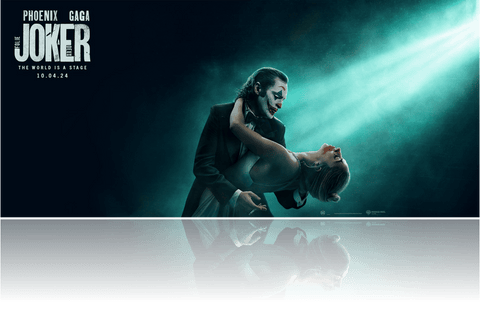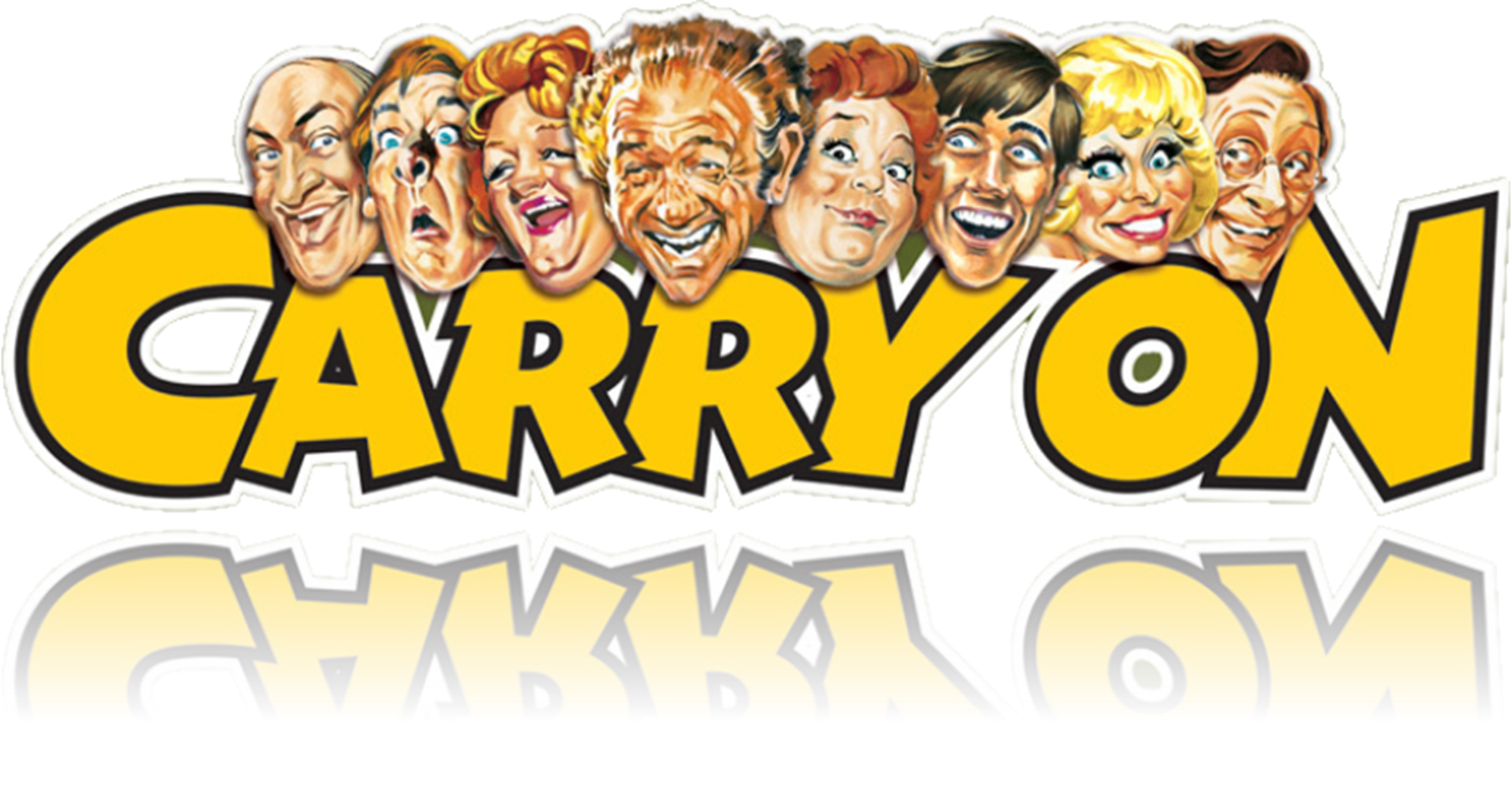
In 2002, film critic Colin McCabe ruffled the feathers of his more snooty peers by committing an act that was, for some, tantamount to heresy. When submitting his picks for the once-in-a-decade Sight and Sound poll of the 100 Greatest Films Ever Made, he included Carry On Cleo and Carry On Up the Khyber.
Those choices were meant to be a little tongue-in-cheek, but they highlighted something that others daren’t acknowledge. If you are appraising British cinema, it would be a dereliction of duty to ignore the success and cultural impact of the much-loved and equally much frowned-upon comedy series.
Beginning in 1958 with Carry On Sergeant, producer Peter Rogers, screenwriter Norman Hudis, and director Gerald Thomas created the template for the longest running British franchise to date. From that initial outing to the dreadful Carry on Columbus in 1992, 31 films were produced in total, raking in a ton of money from limited budgets, turning its core “Carry On Team” into national treasures and, most importantly, making a lot of people laugh along the way.
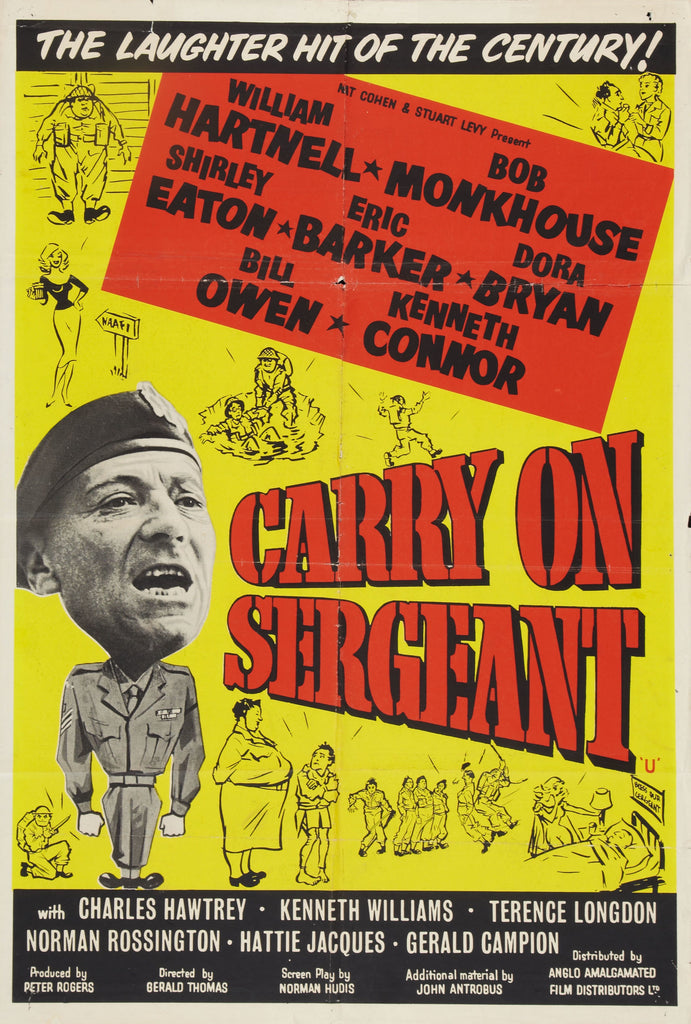
The series was an instant success. While British cinematic comedy in the postwar era was dominated by the films of Ealing Studios, the Carry On series were more lowbrow upstarts of the working class (many of the key members were from inauspicious backgrounds) about the working class, and for the working class. As a result, the public took to the light-hearted shenanigans instantly. Carry On Sergeant, focusing on the exploits of a bumbling group of new recruits in the National Service, was the third biggest box office earner in British cinemas that year.
The first caper featured several actors who would become part of the core team: Kenneth Williams, Charles Hawtrey, Hattie Jacques, Kenneth Connor, and Terry Scott, all playing their roles relatively straight compared to the bawdy excesses on the series’ heyday in the ‘60s. Meanwhile, the headliners were William Hartnell, who would go on to become the first Dr Who; a young comedian named Bob Monkhouse; and Shirley Eaton, who later made such a memorable impression as the ill-fated gilded Bond Girl in Goldfinger.

Three more films followed in a similar vein, lightly thumbing their nose at authority figures, which would become an underlying theme of the series: Carry On Nurse, Carry On Teacher, and Carry On Constable. Another regular, Joan Sims, joined the team in Nurse, and dashing Leslie Phillips came in for a few movies and established one of the series’ early catchphrases: “Ding dong!”
While these early films were quite well-behaved compared to later entries, the Carry Ons courted censorship right away. One of the most contentious issues was the surname of Joan Sims’ character in Teacher, Miss Sarah Allcock. Leslie Phillips recalls how he had to avoid placing emphasis on either “All” or “Cock” to get his repeated use of the word past the BBFC.
Constable is most notable for the arrival of Sid James, who had already become something of a comedy star from his work in a couple of Ealing classics, The Lavender Hill Mob and The Titfield Thunderbolt, and playing Tony Hancock’s down-to-earth foil in the immensely popular BBC radio show Hancock’s Half Hour.

The format was taking shape and director Gerald Thomas, who helmed all 31 of the films, quickly developed a reputation for getting the movies in the can on budget and ahead of schedule. Notably, while the Carry On films are clearly cheap, they are never shoddily made; Thomas served as an associate editor on The Third Man, so he knew a thing or two about making a decent movie.
The 1960s was when the series entered its golden period. Carry On Cruising (1962) was the first entry shot in colour, giving the film a certain threadbare luxury, while the cruise liner where the action takes place was built on the Pinewood Studios lot to keep costs down.
It was also the film where Charles Hawtrey found out that no one was bigger than the Team. When he demanded more money and star billing, he was promptly dropped and replaced by the more cost-effective Lance Percival.
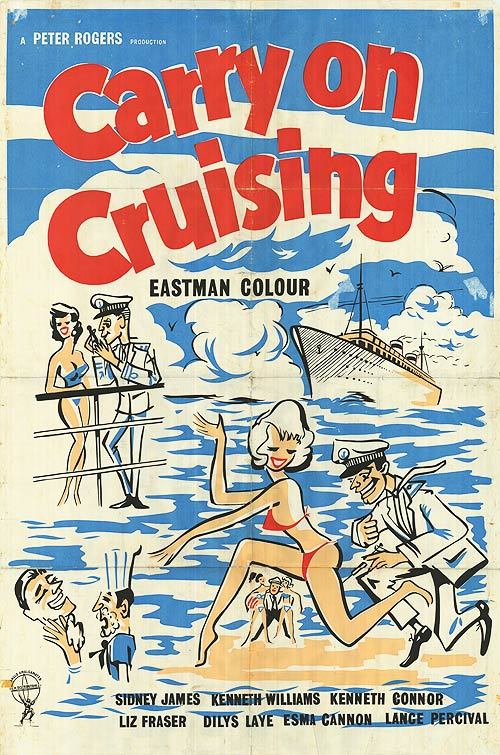
Salary was a contentious issue throughout the series. In a speech at the 40 year reunion of the remaining Carry On Team cast and crew, Peter Rogers joked that he would have done anything for his artists apart from paying them more. The late Kenneth Williams must have turned in his grave at that gag; throughout the franchise, the stars were notoriously poorly paid. It was something that particularly pained Williams, who increasingly became the face of the series through the mid ‘60s and onwards to its demise in the late ‘70s.
The low-key Carry On Cabby (1963) returned the series to black and white for a brief while and also introduced another regular. Pop star Jim Dale, with his pensive good looks placing him somewhere between Norman Wisdom and Cliff Richard, had a productive but relatively short-lived relationship with the franchise. His final film (before returning for Columbus) was six years later in Carry On Again Doctor, in which he memorably performed his own slapstick stunts. In between, he climbed up the ranks to play a major part in some of the best-loved movies in the franchise.
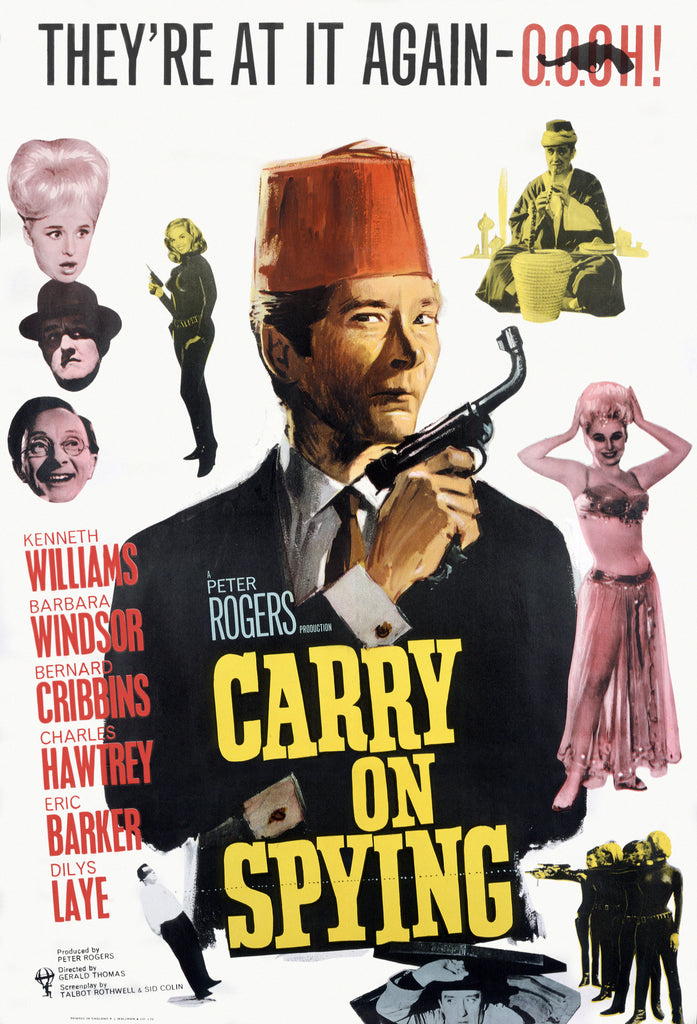
After Cabby, the series hit upon a formula that would take it to new heights: Spoofing whatever was currently big in cinemas at the time. The first of these was Carry On Jack (1964), lampooning historical seafaring epics like Mutiny on the Bounty, followed in the same year by Carry On Spying, which poked fun at the newly-minted James Bond franchise that was filmed across the lot at Pinewood Studios. It riled up Albert “Cubby” Broccoli by attempting to use the codename 006½. Cheekily, they changed it to “Double-O Oh!” instead.
By this stage, Williams and Hawtrey were now camping it up a storm and Barbara Windsor, playing a giggly good-time girl, completed the core team. However, despite bringing a new vivacity and extra personality to the typical “Dolly Bird” role, she lost out on the key part of Cleopatra in the subsequent Carry On Cleo due to a fall out with producer Peter Rogers. Amanda Barrie, following her appearance in Cabby, took the role and it worked out perfectly - she really looked the part and her deadpan delivery was spot on.
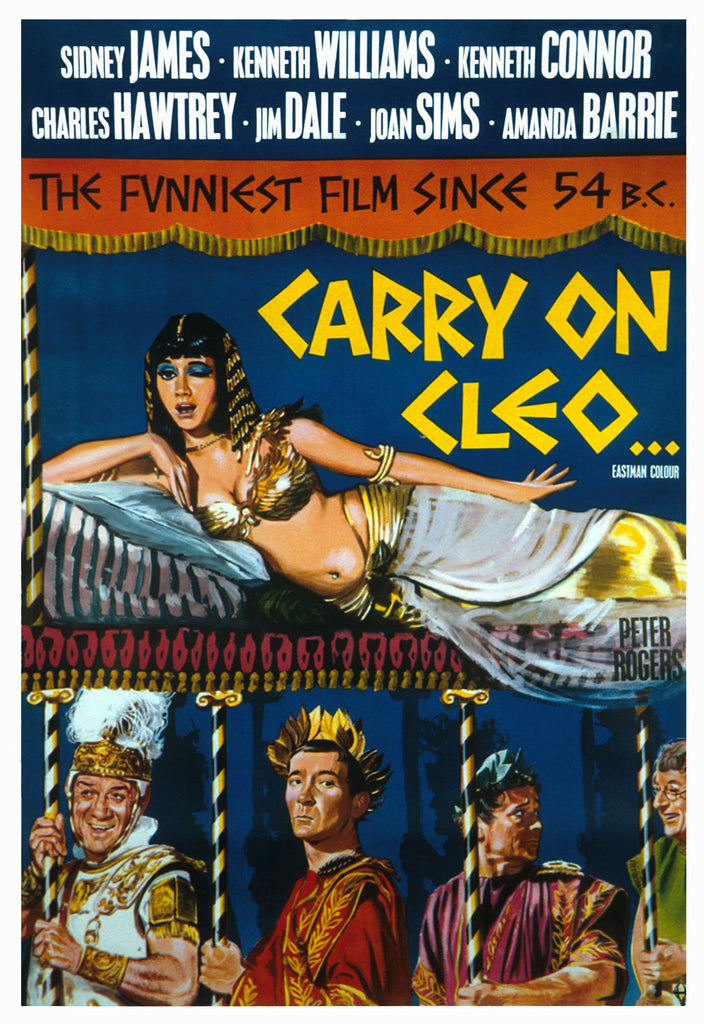
For many fans, Carry On Cleo represents the high point of the series. Once again, the thriftiness of Rogers paid off, having the cheek and wherewithal to use leftover sets and costumes from Liz Taylor and Richard Burton’s Cleopatra, which had decamped from Pinewood to finish shooting in Italy. Thanks to Gerald Thomas’s usual efficiency, the movie beat its big-budget inspiration into theatres.
The end result is one of the most lavish Carry On productions, with a screenplay that was equally opulent by the standards of the series. All the usual boob and toilet jokes are present, but Talbot Rothwell’s script is very clever about being daft. On one hand, it displays a playful irreverence towards history (such as a joke about someone’s mother-in-law getting eaten by a Brontosaurus), while also requiring a basic knowledge of Shakespeare to get the full benefit of the Julius Caesar stuff.
Cleo was one of the films I revisited while researching this article. I hadn’t seen a Carry On movie for probably 15 years or more and my tastes have changed a lot in that time, so I fully expected to be rolling my eyes all the way through it. Instead, it actually had me snorting with laughter on quite a few occasions. It really moves at a cracking pace with plenty of comic energy and the performances are all great - a particular shoutout to Kenneth Connor, one of the series’ most overlooked journeymen. Nobody can sell a “Phwoar!” like Connor.

Another genre spoof followed with Carry On Cowboy (1965), in which Sid James took centre stage and tried on an American accent as the Rumpo Kid. Two more familiar faces, Bernard Bresslaw and Peter Butterworth, also made their debuts for the series.
Carry On Screaming! (1966) was another high point, a ripe and funny sendup of the Hammer Horror movies of the period. Indeed, thanks to the terrific sets and imaginative lighting, it actually looks a lot better than some of the pea-soupers it was spoofing. Against the odds, the film delivered with several key team members missing, not least Sid James who was tied up with panto commitments and replaced by Harry H. Corbett in his lone Carry On outing. Although it is probably best known for Kenneth Williams shrieking “Frying tonight!’ the movie is completely stolen by Fenella Fielding vamping it up as the Morticia Addams-like Valeria Watt.
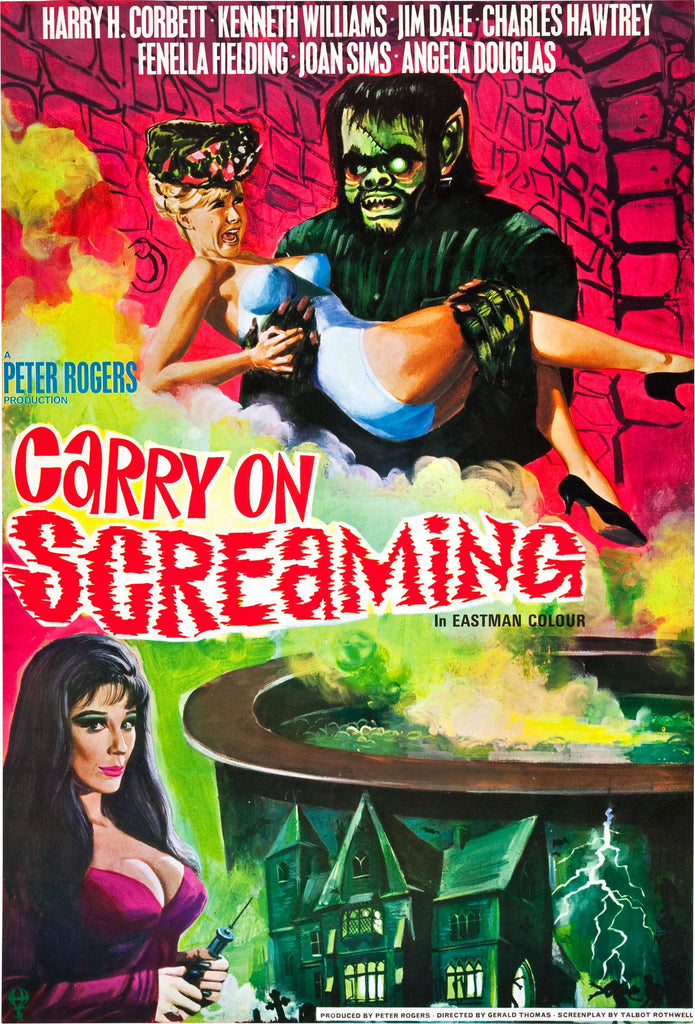
The hits just kept on coming. Peter Rogers attempted to break the American market by casting Phil Silvers in Carry On… Follow That Camel (1967), and the series made a welcome return to a hospital setting (“Matron!”) in Carry On Doctor (also 1967) and Carry On Again Doctor (1969). In between, Barbara Windsor had her infamous bikini malfunction in Carry On Camping (1969) and there was another candidate for the best movie in the series with Carry On Up the Khyber (1968).
While Khyber is one of the most obviously problematic films in the series, with Kenneth Williams and Bernard Bresslaw in brownface and some ignorant gags about other cultures, it is also a riotous send-up of stiff-upper-lips and the pompous gatekeepers of the British Empire. With Sid James rocking it as Sir Sidney Ruff-Diamond, governor of a far-flung Indian province and Joan Sims as his Tiffin-loving wife, the film also concludes with one of the best set pieces of the series as the Khasi of Kalabar (Williams) and his troops lay siege to their mansion and the couple barely notice.

The Carry On films began the ‘70s in fairly good form, but the regular team were beginning to look a little long in the tooth and the format was also showing signs of wear. Carry On Henry, Convenience (both 1971) and Matron (1972) all had strong line-ups, but the wheels started to come off with Carry On Abroad (also 1972). Charles Hawtrey’s alcoholism had become such a problem that he was fired, making the film his 23rd and final appearance in the series. The subsequent Carry On Girls (1973) also missed the presence of Kenneth Williams while taking on a more risque tone, with increased nudity and smutty jokes.

The end was near. Carry On Dick (1974) featured the final appearances in the series Barbara Windsor, Hattie Jacques, and Sid James, who passed away two years later from a heart attack. It was also the last film written by Talbot Rothwell and the remaining movies suffered from a lack of quality, star power, and looked increasingly out of touch with the dour and gritty ‘70s. The series hit a new low in Carry On England (1976) by showing actual naked breasts. Ample cleavages and jiggling bosoms were always a big factor in the Carry On films, but gratuitously putting bare boobs on display felt like a desperate attempt to stay relevant.
After Kenneth Williams and Barbara Windsor presented a compilation of best bits in That’s Carry On! (1977) there was only one film left in the classic era of Carry On Films. It was also the worst. Carry On Emmannuelle (1978) tried to cash in on the wave of softcore erotica in the ‘70s, and by doing so lost all its charm and saucy seaside-postcard style humour. At least it finally put the ailing series out of its misery - until 14 years later, when the franchise was resurrected with Carry On Columbus (1992).
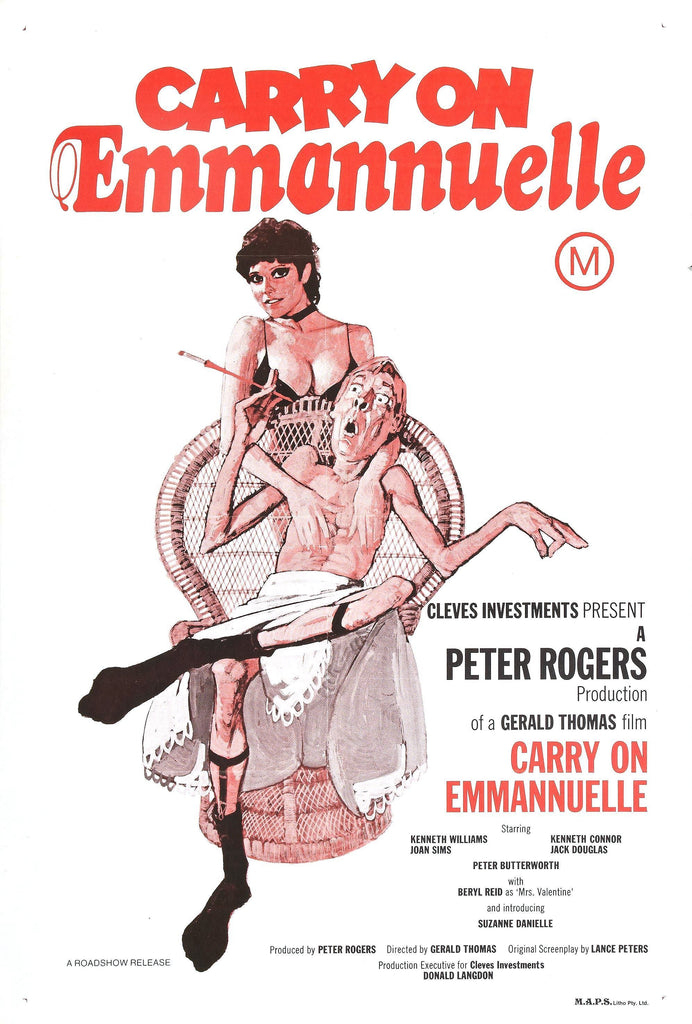
Columbus was a vain attempt to recapture the spirit of the original films while also providing a vehicle for alternative British comedians like Julian Clary, Rik Mayall, and Alexei Sayle. Some of the surviving old-school were still present with Jim Dale, Bernard Cribbins, Leslie Phillips, and lesser lights like Peter Gilmore, Jack Douglas, June Whitfield, and Jon Pertwee.
Carry On Columbus was not a success. Released alongside Ridley Scott’s epic 1492: Conquest of Paradise to coincide with the 500th anniversary of Columbus rocking up in America, it is widely regarded as one of the worst British films ever made. It was a sad end for Gerald Thomas who passed away the following year.
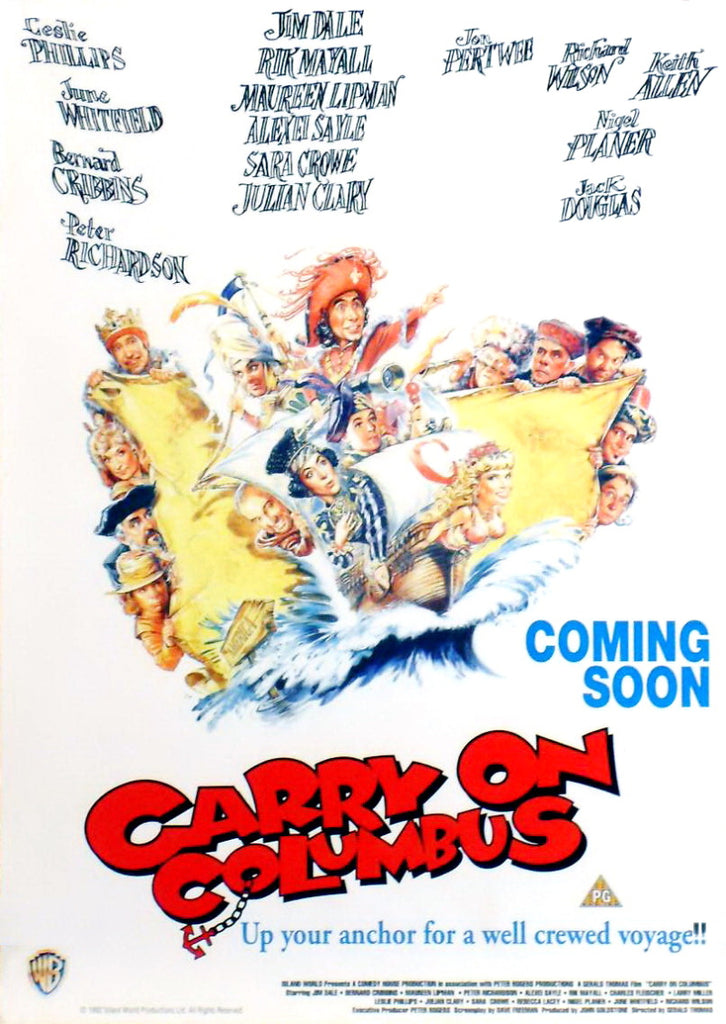
Producer Peter Rogers was planning another film on and off until his death in 2009, with rumours around a new cast including names such as David Jason, Daniella Westbrook, Burt Reynolds, Frank Skinner, Paul O’Grady, Lenny Henry, Justin Lee Collins, Vinnie Jones, and Liza Tarbuck, among others. Say what you want about their individual merits and past accomplishments, but that potential lineup should be enough to make any Carry On fan shudder.
Rumours of a reboot were still lurking around until the past few years, with three movies reported to have been in the works at one point. Thankfully that has all gone quiet.
So here is the big question: Do the Carry On films still hold up? It has become fashionable to take a snarky attitude towards the series and there are plenty of duds that support a negative reading. Naturally, with the modern focus on political correctness, a lot of the material certainly wouldn’t fly today. The films are very much a product of their time but if you want an indication of their comparative quality, try sitting through one of the On the Buses spinoffs or the godawful Confessions movies from the mid ‘70s.
The key thing for the longevity of the series is the cast. Kenneth Williams, Sid James, Hattie Jacques and the gang created such distinctive screen personas that the British public took them to their hearts, and over 40 years later they remain very much in the collective consciousness. Any material, no matter how weak, still has the potential to raise a smile with such a wonderful team of comic talent delivering the lines.
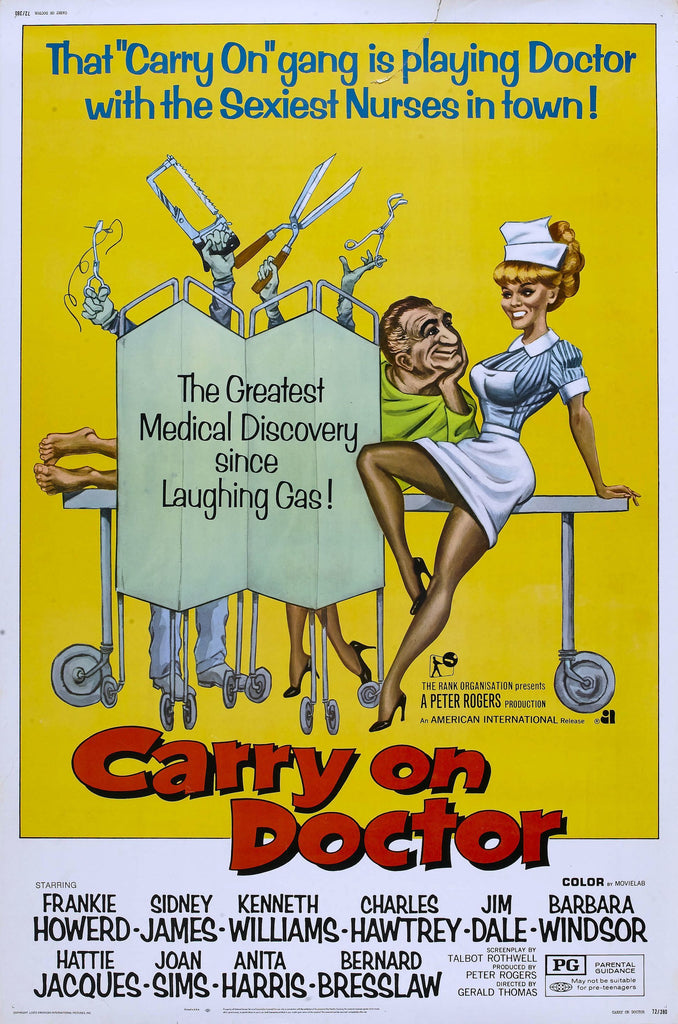
One gag that sticks in my mind comes from Carry On Doctor. Barbara Windsor comes jiggling along the path and is greeted by an ambulance driver who is oafishly munching on a pear.
“Ooh, what a lovely looking pear!” she says, to which he inevitably replies, “You took the words right out of my mouth.”
As entendres go, it is barely single, let alone double, but what sells it is Windsor breaking out into that irresistible naughty cackle. How can you not laugh along with her?
Which brings us to the problematic elements. The Carry On films are often described as sexist, homophobic, and racist. The last of these is the easiest to deal with because the brownface makeup is indefensible, some of the pun-laden names are wince-inducing, and jokes made at the expense of other races and cultures are ignorant at best.
There are some interesting wrinkles to the other two criticisms, however. I’ve read articles by feminist writers and scholars arguing that the Carry On movies are, in fact, feminist. That might be a bit of a stretch, but there is perhaps a case for some of them becoming inadvertently feminist, much in the same way that Russ Meyer’s Faster Pussycat! Kill! Kill! Is now regarded as an accidental feminist classic.
One film in the series that is held up as an example of feminism is Carry On Cabby (1963). Coming along at a time when British society was moving towards greater gender equality, sexual liberation, the pill, and abortion rights, the movie was surprisingly in tune with the era as second-wave feminism was finding its voice. It was released in the same year as Betty Friedman’s seminal The Feminine Mystique was published, a book that introduced the novel concept that women weren’t just content sitting around at home looking pretty and doing the housework. In a similar vein, the women in Cabby get fed up with the blokes’ lame behaviour and set up a rival taxi company of their own, albeit one where they dress in glamorous stewardess-like uniforms.

It goes to show that perhaps the Carry On films weren’t quite as out of step with the times as they appear to the modern eye. While the women in the series are routinely objectified, groped, and leered over by the men, they are also interested in sex in their own right and are increasingly in control of their own destiny. They almost always come across well compared to how the male characters are portrayed, bearing themselves with dignity while the guys look like sweaty-palmed, stammering schoolboys in their presence. Apart from leathery old Sid James, but even his lecherous behaviour is often brought into check by his regular pairing with Joan Sims.
The Carry On series flourished as Britain roused itself from the hardships of the post-war era and moved into the Swinging Sixties. The Beatles had helped kickstart youth culture, young people (including women) were beginning to enjoy sexual liberation, and Harold Wilson’s Labour government enacted many social reforms promoting gender equality and decriminalising homosexuality in 1967.
This makes the case of Kenneth Williams and Charles Hawtrey quite interesting. Gay people weren’t very well represented in British cinema prior to that landmark change in legislation, other than a few key examples like Dirk Bogarde’s powerful performance in Victim (1961). Yet here were two of the biggest stars in the country camping it up in a series of box office hits, which presented a weird paradox at a time when homosexuality was still illegal: Two obviously (to a modern eye) gay guys, making queer jokes and acting flamboyantly camp while playing ostensibly straight men. Indeed, the only openly gay characters to appear in a Carry On film were played by two different actors, John Clive and David Kerman, in 1972’s Abroad. One scholar has suggested that Williams and Hawtrey:
“...would be able to transmit queer messages, while performing within the constraints of heterosexual narratives, ironically mimicking straight expectations while pointing to an alternative reading — in other words, the tactic of camp.”
Williams had form in this respect. He was well-versed in Polari, an obscure language spoken by gay men in the ‘50s and ‘60s to circumvent Britain’s anti-homosexual laws, and regularly used phrases on BBC radio shows. Some of them had around 20 million listeners and several words and phrases have entered British slang.
So while the Carry On movies may be very much of their time and haven’t always aged well, they offer a fascinating snapshot of British society and attitudes towards sex over the two decades between that first hit and the series’ dreary demise. Much to my surprise, some of them are still pretty funny, too!
So there you have it, a brief history of the Carry On series. Do they still hold up for you? If so, which is your favourite? Let us know!




